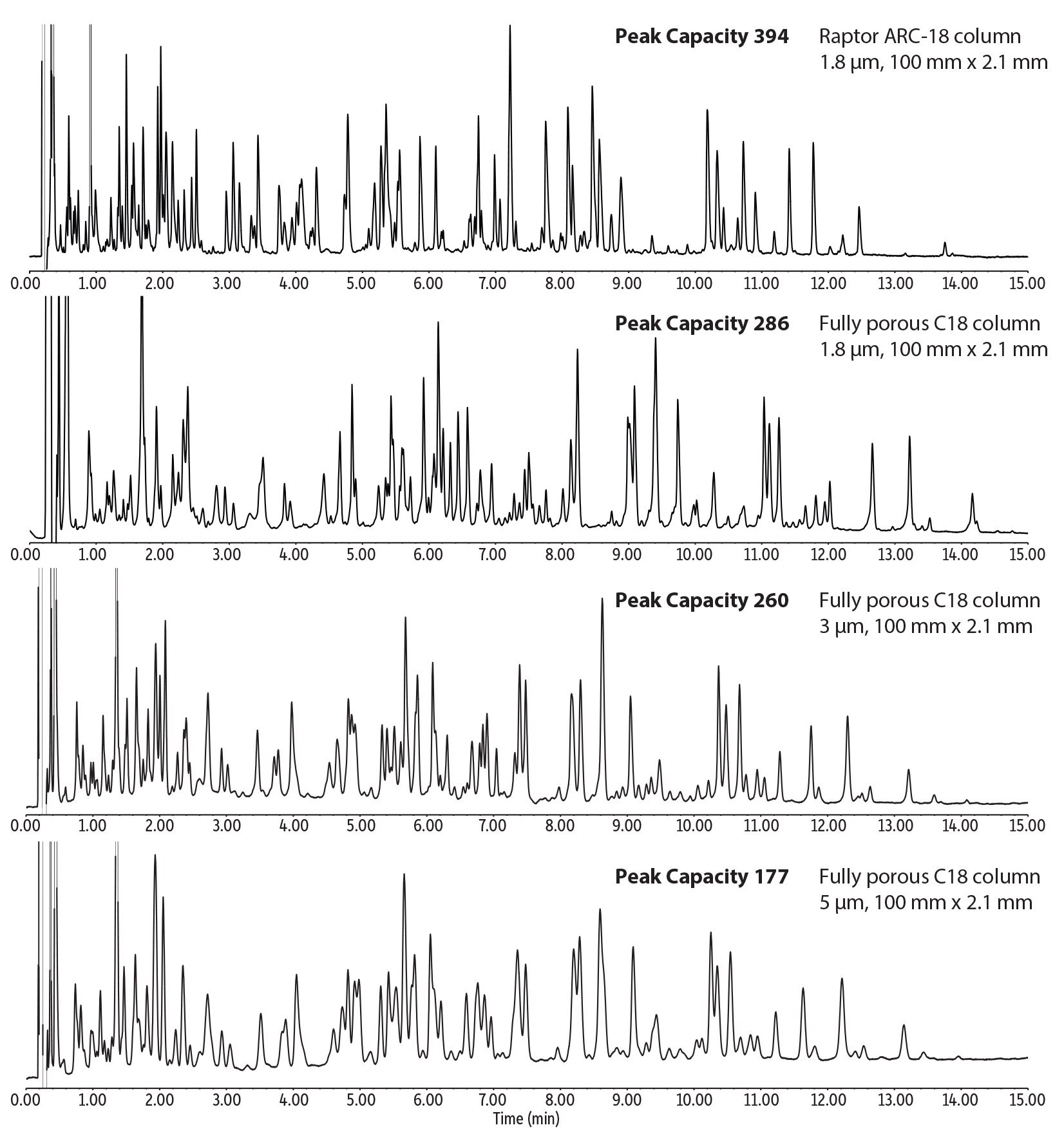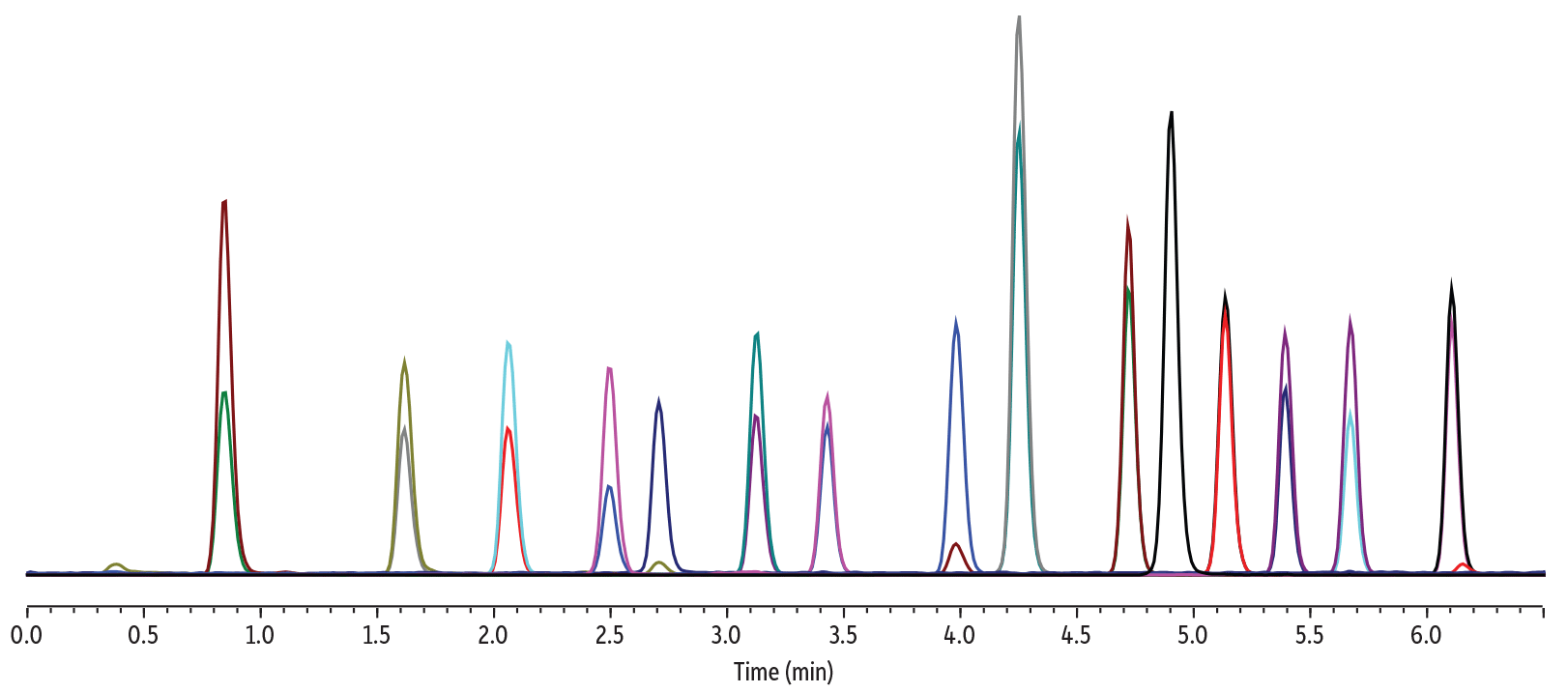The Effects of LC Particle Choice on Column Performance: Raptor 1.8 µm Superficially Porous Particles (SPP) for UHPLC Analyses
Superficially porous particles (commonly referred to as SPP or “core-shell” particles) have been proven to provide fast and efficient LC separations. These particles feature a solid, impermeable core enveloped by a thin, porous layer of silica that offers significantly higher efficiency and sensitivity than traditional fully porous particles (FPP).
At launch, Raptor SPP LC columns were touted for their selectivity and for their ability to help customers achieve faster separations with their existing HPLC instruments. With the launch of Raptor 1.8 µm columns, this superior Raptor performance has been unleashed on your UHPLC analyses. But, what exactly does that mean? In this technical note, we will explore the benefits of using Raptor 1.8 µm LC columns in your UHPLC instrument with a focus on peak capacity, column lifetime, and selectivity.
Handling the Pressure: Peak Capacity
Peak capacity is a valuable measure of system efficiency and is defined by the number of peaks that can be separated by a given chromatographic system and conditions. Raptor 1.8 µm SPP columns offer exceptional peak capacity in UHPLC conditions, far surpassing the performance of fully porous or larger-diameter superficially porous particles. Because Raptor 1.8 µm columns have been designed and extensively tested to prove they can offer the highest levels of peak capacity and resolution, they are especially desirable for complex analyses performed with UHPLC.
The extremely complex samples involved with unknown protein identification, for example, require very high efficiency, which results in high peak capacity. As shown in Figure 1 with the analysis of tryptic digested proteins, the selectivity and ruggedness of Raptor columns combined with these small 1.8 µm superficially porous particles designed for high-pressure use allow chromatographic conditions to be tailored to produce incredibly high peak capacities on UHPLC instrumentation.
Figure 1: Maximize peak capacity and efficiency, even for complex samples, by switching to Raptor 1.8 µm columns on UHPLC instrumentation.

| Column | Raptor ARC-18 (cat.# 9314212) | ||||||||||||
|---|---|---|---|---|---|---|---|---|---|---|---|---|---|
| Dimensions: | 100 mm x 2.1 mm ID | ||||||||||||
| Particle Size: | 1.8 µm | ||||||||||||
| Pore Size: | 90 Å | ||||||||||||
| Temp.: | 60 °C | ||||||||||||
| Standard/Sample | |||||||||||||
| Diluent: | 0.1% TFA in water | ||||||||||||
| Conc.: | 1,750 µg/mL total BSA concentration before digestion | ||||||||||||
| Inj. Vol.: | 10 µL | ||||||||||||
| Mobile Phase | |||||||||||||
| A: | 0.1% Trifluoroacetic acid in water | ||||||||||||
| B: | 0.1% Trifluoroacetic acid in acetonitrile | ||||||||||||
| |||||||||||||
| Flow: | mL/min |
| Detector | PDA @ 207 nm |
|---|---|
| Instrument | UHPLC |
| Notes | A flow rate of 1.1 mL/min was used for all columns, except for the 1.8 μm fully porous column. The flow rate used for that column was 0.8 min/mL, in order to prevent excessive backpressure. |
Handling the Pressure: Column Lifetime
High-throughput labs require reliable performance run after run. Rugged 2.7 and 5 µm Raptor columns quickly became trusted for their long lifetime, giving analysts the confidence they needed to set up long sequences of samples on their HPLCs without fear of rework or lost productivity. Before they could be released with the Raptor name, these new 1.8 µm columns were thoroughly tested (Figure 2) to prove that their phase chemistry, packing procedures, and hardware could equally withstand the rigors of UHPLC conditions—run after run, column after column.
Figure 2: Comparing 50 mm x 2.1 mm sub-2 µm C18 columns, Raptor 1.8 µm columns maintain reliable UHPLC performance past 1,000 injections at 12,000 psi, consistently matching or beating the competition.
Handling the Pressure: Selectivity
The higher pressures of UHPLC don’t necessarily impact selectivity, but that still doesn't mean that all UHPLC columns can handle your compound lists with acceptable results. Raptor LC columns represent the fusion of SPP speed with the selectivity of USLC technology, so you get the separating power of Restek’s stationary phases combined with the speed, peak capacity, and reliability of a Raptor column—all in a smaller particle that provides greater efficiencies in a UHPLC environment.
For example, Restek’s novel, time-tested Biphenyl phase, applied to Raptor 1.8 µm particles and run under UHPLC conditions (Figure 3), achieves difficult separations with faster analysis times for greater sample throughput. Many of the analyses we run impact the public’s health and safety; in this case, bisphenol A and its many analogs pose a significant health risk. It is paramount that you get accurate results as quickly as possible—a task easily handled using a highly selective Raptor LC column with 1.8 µm particles, even without complicated mobile phase formulations.
Figure 3: The speed, peak capacity, and reliability of Raptor SPP columns come to UHPLC with the selectivity of Restek’s USLC phases—in this example, the Raptor Biphenyl 1.8 µm column resolves fifteen bisphenolic compounds to baseline using simple mobile phases in 8 minutes!

| Peaks | tR (min) | Conc. (ng/mL) | Precursor Ion | Product Ion | Product Ion | |
|---|---|---|---|---|---|---|
| 1. | Bisphenol S | 0.84 | 5.00 | 249.2 | 108.1 | 92.1 |
| 2. | Bisphenol F | 1.62 | 350 | 199.3 | 93.1 | 105.1 |
| 3. | Bisphenol E | 2.06 | 100 | 213.3 | 198.3 | 197.4 |
| 4. | Bisphenol A | 2.50 | 100 | 227.3 | 212.3 | 133.1 |
| 5. | Bisphenol AF | 2.71 | 2.00 | 335.2 | 265.3 | 177.3 |
| 6. | Bisphenol B | 3.13 | 100 | 241.3 | 212.4 | 211.3 |
| 7. | Bisphenol C | 3.43 | 350 | 255.3 | 240.4 | 147.3 |
| Peaks | tR (min) | Conc. (ng/mL) | Precursor Ion | Product Ion | Product Ion | |
|---|---|---|---|---|---|---|
| 8. | Bisphenol AP | 3.98 | 25.0 | 289.3 | 274.3 | 273.3 |
| 9. | Bisphenol Z | 4.25 | 250 | 267.2 | 173.4 | 145.2 |
| 10. | Bisphenol G | 4.72 | 250 | 311.2 | 295.4 | 296.4 |
| 11. | Bisphenol FL | 4.90 | 50.0 | 348.8 | 256.2 | - |
| 12. | Bisphenol BP | 5.14 | 50.0 | 351.2 | 273.3 | 274.3 |
| 13. | Bisphenol M | 5.39 | 15.0 | 345.2 | 330.3 | 251.4 |
| 14. | Bisphenol P | 5.67 | 50.0 | 345.2 | 330.4 | 315.3 |
| 15. | Bisphenol PH | 6.11 | 350 | 379.2 | 209.4 | 364.4 |
| Column | Raptor Biphenyl (cat.# 9309252) | ||||||||||||||||||||
|---|---|---|---|---|---|---|---|---|---|---|---|---|---|---|---|---|---|---|---|---|---|
| Dimensions: | 50 mm x 2.1 mm ID | ||||||||||||||||||||
| Particle Size: | 1.8 µm | ||||||||||||||||||||
| Pore Size: | 90 Å | ||||||||||||||||||||
| Temp.: | 25 °C | ||||||||||||||||||||
| Standard/Sample | |||||||||||||||||||||
| Diluent: | 75:25 Water:methanol | ||||||||||||||||||||
| Conc.: | 2.00-350 ng/mL | ||||||||||||||||||||
| Inj. Vol.: | 2 µL | ||||||||||||||||||||
| Mobile Phase | |||||||||||||||||||||
| A: | Water | ||||||||||||||||||||
| B: | Methanol | ||||||||||||||||||||
|
| Detector | MS/MS |
|---|---|
| Ion Mode: | ESI- |
| Mode: | MRM |
| Instrument | UHPLC |
Conclusion
Raptor columns have been providing higher efficiencies, faster analyses, and rock-solid reliability to HPLC users for several years. Now, their signature superficially porous particles, selective phase chemistries, and unbeatable quality have made the leap to UHPLC instruments. The first question that comes to mind when many analysts think of UHPLC is one of pressure. Specifically, can Raptor 1.8 µm particles handle the high backpressures of UHPLC? The answer is yes. Raptor 1.8 µm columns offer outstanding peak capacity, column lifetime, and selectivity for the UHPLC analyst.

